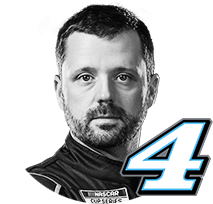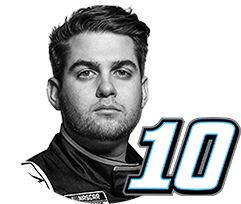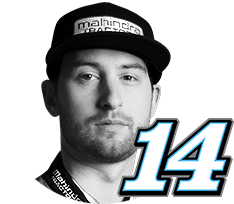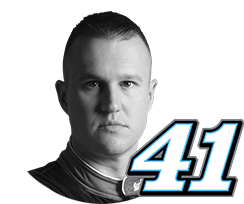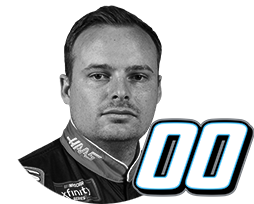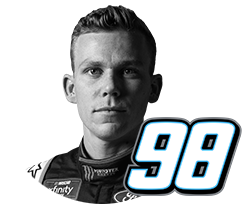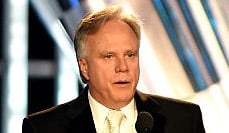Prior to visiting victory lane in the Foxwoods Resort Casino 301 last Sunday afternoon at New Hampshire Motor Speedway in Loudon to secure his position in the NASCAR Cup Series playoffs, Kevin Harvick was asked about the current state of NASCAR racing tactics.
His comment was very simple.
“If you drove like this 10 years ago, you’d have a fist in your mouth.”
Harvick, driver of the No. 4 Busch Beer Ford Mustang for Stewart-Haas Racing (SHR), is one of the last remaining Generation X drivers to experience such history in NASCAR, and he used his vast driving experience when he battled door-to-door and banged fenders with Denny Hamlin in the thrilling final lap at New Hampshire to score his first race win of the season. It put him in position to race for his second Monster Energy NASCAR Cup Series championship.
Generation X is pretty much defined as anyone born between the years 1965 and 1980. Harvick was born in 1975, grew up during the 1980s, and made his NASCAR touring series debut in the Gander Outdoors Truck Series in 1995 at the age of 19 and now stands as an elder statesman in the Cup Series.
Even his personal “Happy Harvick” logo of a smiley face with flames is a takeoff of the original smiley face logo created in the late 1960s and made popular in the 1970s. It was slightly altered to highlight his rather sunny disposition off the track while being known for his fiery personality behind the wheel.
The folks at Busch Beer, who read some comments Harvick made in 2018 about older guys being better than the heavily hyped younger guys in the Cup Series garage, came up with a pink Millennial Car for the Monster Energy NASCAR All-Star Race at Charlotte (N.C.) Motor Speedway after millennial driver Joey Logano won the Cup Series championship in 2018.
Busch is at it again, but this time in a way more fitting for its driver’s generation – a No. 4 Busch Beer Gen X #4The Cup Ford Mustang. The car will sport images of things that Gen Xers once embraced, including boom boxes, skateboards, and words like “gnarly” and “fresh.” Generation X also is known for MTV (yes, there were music videos), 8-bit video games (Zelda anyone?), Miami Vice (White Suits rule), and making mix-tapes for their boom boxes or Sony Walkman (Hello, Huey Lewis and the News). While Gen Xers certainly have their gnarly style quirks, they also have a hardened edge to their personality.
Generation X is known for earning it, something Harvick is still looking to do for the first time at Pocono (Pa.) Raceway, where the Cup Series Gander RV 400 takes place Sunday. He has won at every track on the NASCAR circuit save for Pocono and Kentucky Speedway in Sparta. But he’s finished in the top-10 in eight of 11 races at Pocono since joining SHR, including four runner-up finishes.
In his six seasons with crew chief Rodney Childers at SHR, the duo has combined to produce 23 points-paying victories, a victory in the non-points-paying 2018 Monster Energy NASCAR All-Star Race at Charlotte, 22 poles, 100 top-five finishes and 139 top-10s while leading 9,140 laps.
They won the 2014 championship, finished runner-up in the 2015 title chase to champion Kyle Busch, finished eighth in 2016 and third in 2017 and 2018. The team has qualified for the Championship 4 at Homestead-Miami Speedway four times in the last five years.
Perhaps, if Harvick wins at the 2.5-mile oval this week, he’ll play a little music – on his old Walkman, per chance? – to celebrate, something like “You’re the Best Around” by Joe Esposito from the 1984 movie, The Karate Kid.
Because a participation trophy is not needed – Harvick wants to earn this trophy.
That is what Gen Xers do.
KEVIN HARVICK, Driver of the No. 4 Busch Beer Gen X #4TheCup Ford Mustang for Stewart-Haas Racing:
When did this style of racing start with guys racing all over the track? Many people feel like it wasn’t that way 10 years ago.
“If you drove like this 10 years ago, you’d have had a fist in your mouth. What changed were the rules and, when every spot becomes that much more difficult to achieve, you have to defend the spots that you have because you know that you might not get it back, and you know that you have to block. Blocking is a part of what we do. Defending your position is a part of what we do and it’s just an evolution of where the rules package is. Heck, I had a blown motor (at Kentucky Speedway), a broken engine and was only three-tenths off the pace, so you’re talking about small amounts of time, especially on the mile-and-a-half racetracks, where you know if you can keep somebody behind you – and that comes with side-drafting and blocking and all those things – that if they’re directly behind you, there’s no way they’ll pass you because of the aero.”
There will be PJ1 at Pocono. What are your thoughts on that?
“Our car was extremely fast there last time and the steering box broke, so I feel like we had a lot to build on for us individually as an organization and team we’re still trying to recover from not being where we needed to be to start the season. The progression for us has been rapid. There have been a lot of different things that have been tried as we’ve gone over these last two months and we’re still building and trying to get the cars exactly where we’d like them to be, but Pocono was definitely a race we could have won with the circumstances going right, and it seems like on the days where we’ve had chances to win, we’ve just either made mistakes or we’ve had something go wrong. It’s probably been three or four, maybe five times this year, that we’ve had those opportunities and just haven’t capitalized on them, but Pocono was definitely one of those races. I feel like we’ve been able to hopefully make the car better than it was last time. I think we’ve done that every week, so I think as you go there with the PJ1, a lot of that came from the meeting at Daytona with the communication from the drivers and NASCAR and everybody trying to figure out how to make the racing better there. And, with these particular cars and the way that passing has been so difficult, lanes are a good option for all of us to make the racing better. I think, from the outside looking in, the race is OK to watch. From inside the car, it’s a little bit frustrating just because of how difficult it has been to pass at some of the racetracks, so I think with as much better as we are as a sport in adding the PJ1 at a lot of these racetracks and seeing the results. I mean, it was way better at Kentucky than it had been in the past. You look at this particular racetrack and Bristol and we’ve just done a lot better job. You look at the science that goes into when you spray it, how you spray it, all the things that come into play, the long and short of the story is we’ve just become a lot better at the traction compound and the things that we do, and when we put it down and where we put it down, and you see a lot more people open to it because it’s more consistent. We need lanes as drivers in order to go where the other car isn’t in order to pass, and I think that’s really the reasoning behind Pocono.”
Regarding your mental approach to each week and your capability of winning a race, was there some personal satisfaction that all of it was able to be put into place last week at New Hampshire?
“Honestly, I’m excited that we won, but it doesn’t really – we won’t have a different meeting than if we didn’t win. We won’t have different conversations. We won’t treat each other any differently. It really doesn’t change anything. I mean, honestly, this is what we’re supposed to do. This is what we get paid to do. And it’s our job, and we expect it. We expect to go out and win races, and on the days – and I said this for several weeks, now it’s almost a game of how do we fix it, how do we get to where we need to be, and how do we put ourselves in position to try to win a championship. Sometimes those years are more fun just because – more fun in the end. They aren’t more fun in the middle just because of the conversations, but the satisfaction that comes out of turning things around is sometimes more rewarding just because of the fact that it takes a lot of people to do it. Like you really have to step back and realize that I can drive the car, but there is no way I can do anything close to the amount of work that goes into putting these cars into production on the racetrack, changing things. I’m just a small, small sliver of it. But, I can tell you, confidence is never anything that we will lack.”


